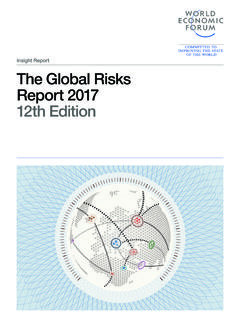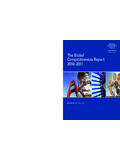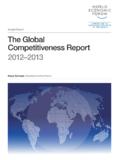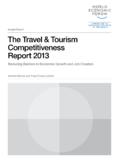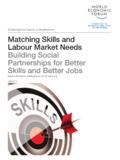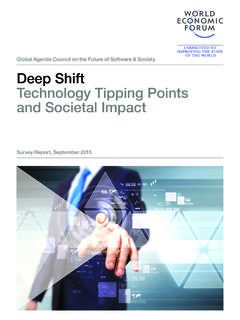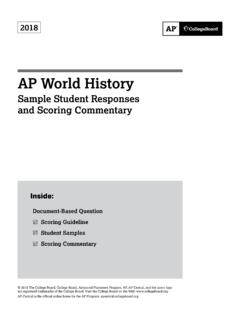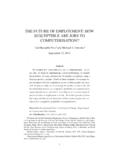Transcription of Reimagining Regulation for the Age of AI: New Zealand ...
1 Reimagining Regulation for the Age of AI: New Zealand Pilot ProjectWHITE PAPERJUNE 2020 ContentsIntroduction1 Project overview 2 Reimagining AI Regulation 3 Focus areas National conversation Regulatory capabilities and institutional Risk/benefit assessment of AI systems for governmentConclusionContributorsEndnotes 34813141720242527 2020 World Economic Forum. All rights reserved. No part of this publication may be reproduced or transmitted in any form or by any means, including photocopying and recording, or by any information storage and retrieval Regulation for the Age of AI: New Zealand Pilot Project2 IntroductionOver the past decade, artificial intelligence (AI) has emerged as the software engine that drives the Fourth industrial revolution , a technological force affecting all disciplines, economies and industries.
2 AI-powered services are already being applied to create more personalized shopping experiences,1 drive productivity2 and increase farming efficiency. In the future, they will enable the rise of self-driving cars3 and the large-scale access to precision medicine with appropriate data AI systems have been able to do so thanks to the exponential growth of human and machine-generated data leveraged by powerful machine learning algorithms,5 whose performance on a given task increases with labelled data. This recent progress is remarkable in important respects, but also creates unique challenges.
3 Indeed, without proper oversight, AI may replicate or even exacerbate6 human bias and discrimination, cause potential job displacement7 and lead to other unintended8 consequences. This is particularly problematic when AI is deployed in high-stakes domains such as criminal justice,9 healthcare,10 banking11 or Government officials throughout the world are increasingly aware of both the opportunities and risks associated with AI and urged to act as AI s influence over society increases at a fast pace. They also acknowledge that some form of AI Regulation is needed, with AI systems used by governments an early focus, given the duty of care owed to citizens, particularly as governments make highly consequential decisions supported by , regulating AI is a complex endeavour.
4 Experts hold diverse views on what areas and activities should be regulated, and approaches to regulating AI diverge sharply across regions. In some jurisdictions, a lack of consensus on a path forward and the risk of stifling innovation may deter any action. Emerging controversies surrounding AI can also force governments to implement hastily constructed and suboptimal regulatory policies. What is possible, however, is to start to address some of the key issues in AI through tangible solutions and tools that could be leveraged by national this end, the World Economic Forum is spearheading a multistakeholder, evidence- based policy project in partnership with the Government of New Zealand .
5 The project aims at co-designing actionable governance frameworks for AI Regulation . It is structured around three focus areas: 1) obtaining of a social licence for the use of AI through an inclusive national conversation; 2) the development of in-house understanding of AI to produce well-informed policies; and 3) the effective mitigation of risks associated with AI systems to maximize their benefits. For each of these areas, the World Economic Forum s Centre for the Fourth industrial revolution under the Platform for Shaping the Future of Technology Governance: Artificial Intelligence and Machine Learning has produced frameworks and guidelines that, once combined, contribute to the development of an appropriate regulatory environment for the next stage, the Centre intends to pilot the frameworks to develop a better understanding of what works and why.
6 This white paper is the first step in an iterative process, and welcomes participation of organizations willing to engage in this debate and join the Regulation for the Age of AI: New Zealand Pilot ProjectJune 2020 Reimagining Regulation for the Age of AI: New Zealand Pilot Project3 Project overview1 Below: New Zealand ParliamentThis is the first global multistakeholder effort to co-design regulatory frameworks for AI informed by policy pilotsReimagining Regulation for the Age of AI: New Zealand Pilot Project4 The World Economic Forum Platform for Shaping the Future of Technology Governance: Artificial Intelligence and Machine Learning is guided by a vision of accelerating and scaling the social benefits of emerging technologies while mitigating their risks.
7 To execute this vision, the Platform which is guided by the Forum s Centre for the Fourth industrial revolution applies an agile governance methodology to develop actionable frameworks or toolkits through a multistakeholder approach that brings together governments, companies, civil society and academia. The Centre partners with governments and companies to pilot the frameworks, capture lessons and create guidance to support broad scaling and self-service adoption. The Platform develops projects within three distinctive areas: enabling frameworks, high-risk use cases and leapfrog opportunities.
8 Projects in the first category which includes Reimagining Regulation for the Age of AI aim to create enabling frameworks that support the operationalization of the ethical use of artificial intelligence. Earlier projects have done this in a variety of contexts, including government procurement, corporate operational management and corporate governance. This project complements the existing portfolio by addressing the potential need for the Regulation of AI in some with the New Zealand governmentProject timelineNew Zealand is the sponsor government for this project.
9 A number of initiatives in New Zealand such as the government s Algorithm Assessment Report,13 the Centre for AI and Public Policy, Otago University report, Government Use of AI in New Zealand ,14 and the AI Forum of New Zealand s work on AI in the economy and society15 have raised the importance of AI and explored opportunities, but the government has not yet developed an AI project is seen as an opportunity to work with leading experts in AI to help New Zealand shape its domestic position on emerging technologies.
10 New Zealand has expressed interest in working with the Centre for the Fourth industrial revolution on this topic, given the need for a global, multistakeholder perspective on the complex question of regulating AI. New Zealand has been keen to work with the Centre to identify tools and approaches that would promote innovation, protect society and build trust in AI use. Its view is that ethical frameworks need to underpin technology development, and New Zealand s bicultural foundation and multicultural make-up means it is committed to working with communities to build and maintain social licence for the use of this paper, social licence is defined as people giving approval to an organization they deem trustworthy enough to undertake specified, potentially risky activities.

